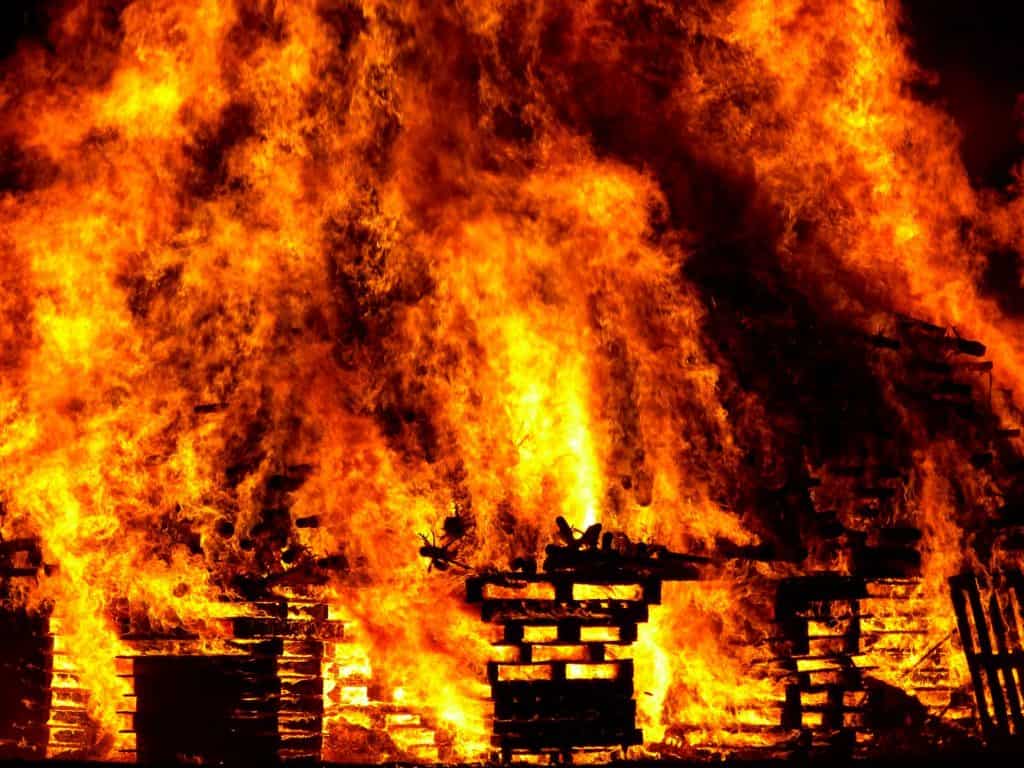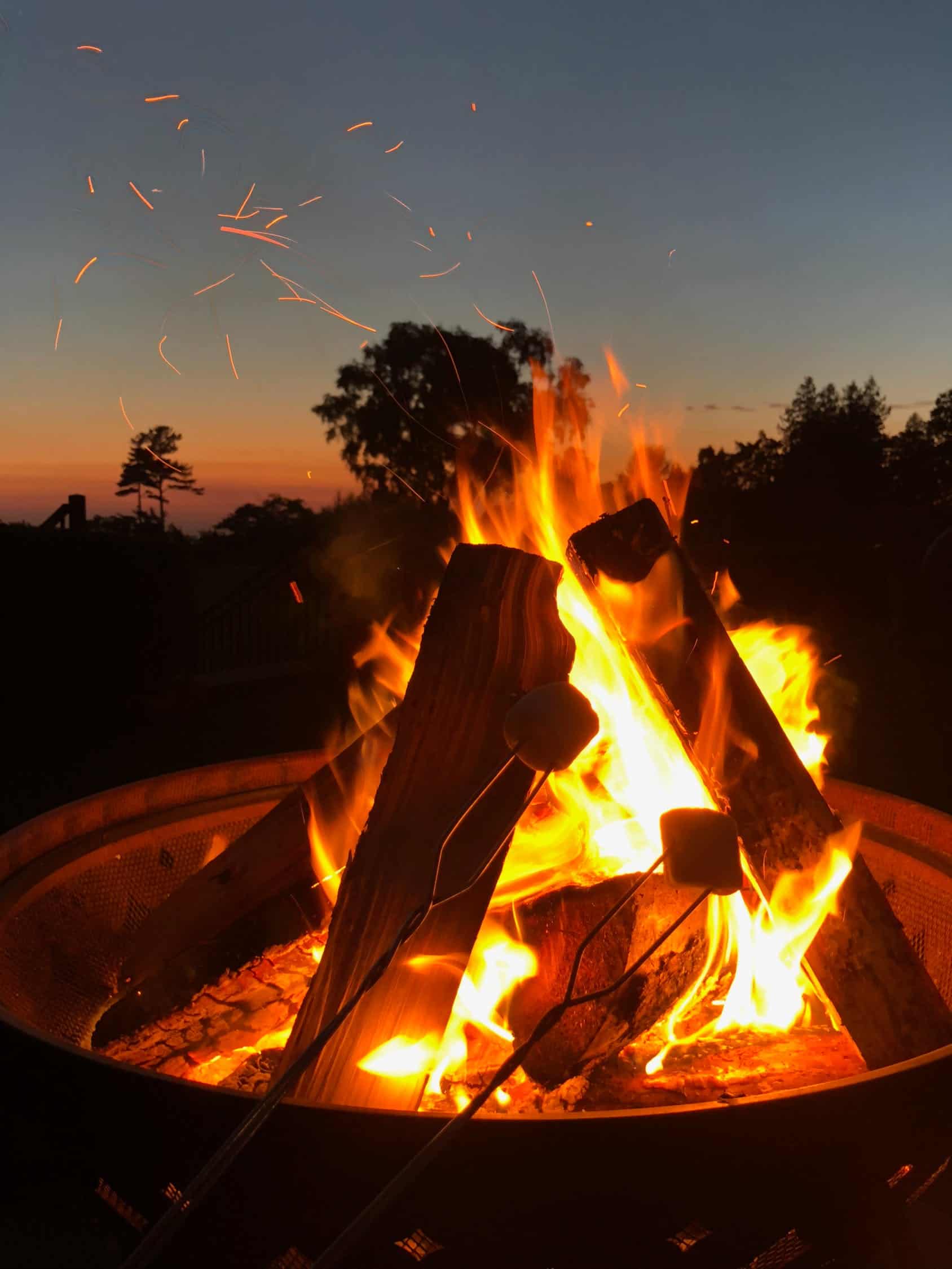What’s better than a patio at dusk in early Summer? A patio at dusk in early Summer… with a fire pit.
Nothing complements a slightly cool evening better than the crackling of burning firewood in the moonlight.
Let me set the scene for you — the flames dance joyously on the wall of your house, the smoldering wood fills the air is filled with the smell of charred oak.
And then… BOOM!
Shrapnel falls all around you and your heart is about to burst out of your chest. The heat from your outdoor fire pit just caused your patio to explode. Is this a work of fiction, or can a fire pit damage concrete patios?
Long-time reader Stefanie H. had the same question:
Hey Captain! My wood burning fire pit is causing my grass to die and I was hoping to move it onto our patio. Is this safe?
Stefanie H. Atlanta, GA.
Well Stefanie, Captain Patio is here to give you some guidance. Are you ready?
A wood-burning fire pit will damage an unshielded concrete patio over time. It generally does not result in an explosion but appears as rapid erosion or discoloration. Propane fire pits tend not to have the same kind of problem. You can easily remedy this problem with a quality fire pit mat.
Some fire pits can seriously damage your concrete patio, others are remarkably safe. But even if you have one of the dangerous units, you can take steps to mitigate the problems.
Can Wood Burning Fire Pits Damage Concrete?
First, let’s start with the dangerous kind of fire pits.
Wood burning fire pits typically have a wrought-iron, aluminum, or copper bottom meant to conduct heat well. This is great when you have folks crowded around it for warmth. It’s not so good when it’s sitting a mere six inches above your concrete patio.
In fact, the heat from an unmitigated fire pit can cause your concrete patio to literally explode.

As an aside, if you regularly enjoy your outdoor fire pit, you should consider getting a fire extinguisher. And always make sure you keep it inspected and up to date — you want to make sure it works when you need it! My recommendation is this rechargeable model from First Alert.
What causes the concrete in your patio to explode?
Small air bubbles are trapped inside concrete during the pour and spreading process. This isn’t due to negligence, instead, it’s just an unfortunate byproduct of the craft. It’s physically impossible to remove all possible air bubbles before the concrete dries.
Fast forward to the Summer night on your concrete patio.
The heat from the fire pit has reached 1,000° Fahrenheit and is radiating down toward the trapped moisture/air bubbles. As we learned in Science class, heated gas expands.
When you heat gas greatly, it stands to reason that it expands greatly. So the heated gas expands, building up pressure until… POP — the patio explodes while throwing concrete shrapnel all over you and your guests.
Okay, okay. It’s usually not this dramatic, although it can be (check out YouTube).
The most likely scenario is that the heat from your fire pit will slowly damage your concrete over time, causing spalling, cracking, and a generally weakened surface. So yes, wood-burning fire pits can damage concrete patios.
That being said, the solution to prevent this kind of catastrophe is remarkably simple. You can put something under your fire pit to stop the heat transfer dead in its tracks!
What Do You Put Under A Fire Pit To Protect Your Patio?
Fire pit pads are protective heat shields. You place these heat-resistant accessories between the fire pit and the concrete patio/wooden deck underneath to protect your patio.
Since they’re made of volcanic rock/carbon fibers, they easily stop the heat from ever reaching the other side. If you use them properly, they’ll keep your patio safe.
I highly recommend the Deckprotect Fire Pit Mat & Rack. The manufacturers tested it at temperatures of 1,400° Fahrenheit and it can withstand almost anything you can throw at it.
Depending on which size you need, the mat typically costs less than $150. This absolutely pales in comparison to the cost of repairing your precious patio (the price of the pad tends to change, so check Amazon for the most up to date info).
Are Patio Pavers Safe For Fire Pits?
If your patio uses pavers, it’s a different story altogether.
Kiln-fired brick withstands temperatures a lot higher than what your wood-burning fire pit is likely to produce. Even landscaping brick should stand up to the heat fine. Yes, patio pavers are safe underneath fire pits.
However, the heat can discolor patio pavers depending on the type of materials used. If you’re concerned about discoloration, simply install a fire pit mat (like the one linked above).
We’ve covered wood-burning fire pits and their danger to patios, but what if your fire pit uses a different kind of fuel?
Will a Fire Pit Damage Asphalt?
If your patio area contains any asphalt at all, it’s probably best that you don’t have a fire pit anywhere near it.
Asphalt is a petroleum product, meaning that it can actually catch fire.
Oil fires are difficult to put out and it’s likely that the fire department would need to be involved. That’s a sure-fire way to ruin a summer evening.
Can Propane Fire Pits Damage Concrete Patios?
I’ll go ahead and tell you: no, propane fire pits will not typically damage concrete patios. I’m not saying it never happens, but generally, the flames don’t burn hot enough to create any sort of explosion.
This is one safety benefit of gas-burning fire pits. They can only produce so many BTUs, whereas a wood-burning fire pit keeps getting hotter with more fuel. We wrote all about fire pit BTUs here if you’re interested!
Stay Safe Out There
No matter what type of fire pit you have, it’s important to exercise caution when using it. Along with heights, fire is one of man’s natural fears (and for good reason).
Always have a fire extinguisher handy and never act recklessly with a burning flame. The Captain wants to keep all of his readers happy and healthy!

